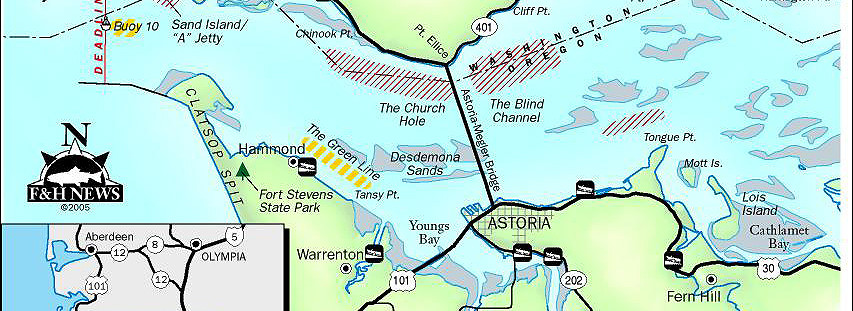
Buoy 10 is a marker for ships located at the mouth of the Columbia River. But for fisherman, it is arguably one of the most productive salmon fisheries in the lower 48. Just a two hour drive West of Portland, Oregon, it draws anglers from Oregon, Washington, the West Coast and further. The buoy itself marks the western parameter of the managed fishery. But the fishery extends far east of Astoria to Tounge Point. I grew up listening to stories my grandfather would tell me about epic fishing at Buoy 10 including the famous “Church Hole” which is between the town of Chinook entrance and the bridge on the Washington side. There is a church and it’s steeple is very visible.
The area opens for chinook retention and fin-clipped hatchery coho on August 1st each year. Strong returns of 925,000 fall chinook and 540,000 coho are forecast to enter the Columbia River this year. This fishery will generally continue into late August and occasionally is extended into early September. Thousands of anglers travel to this area to target these large Columbia “Upper River Bright” Chinook and Coho salmon. The other large group of Chinook found in the Columbia River Estuary are known as “Thules”. They spawn in the lower Colombia and tributaries and generally are not as bright as long as the upper river brights.

WHAT TO EXPECT
This fishery can get very crowded. It is not uncommon to have over 200+ boats in a one-mile area. Anglers launch from both the Astoria/Warrenton side and also the Ilwaco/Chinook side. There are approximately 5 launches on the Washington side and 4 on the Oregon side. The estuary can get very rough without much notice. Winds will generally increase later in the morning and/or afternoon, but can develop without any warning at all. Thoroughly review a map of the area prior to your arrival to familiarize yourself with potentially hazardous sand bars and channels. The area can be very unpredictable and presents a lot of shallow water characteristics which coincide with strong tides.
REGULATIONS
Adult chinook must be a minimum of 24 inches and adult coho must be 16 inches. The retention limit is two adult salmon, only one of which can be a chinook. Check the Washington Department of Fish & Wildlife website for specific information and changes to this fishery. You can also refer to the Oregon Department of Fish & Wildlife website for more details on retention limits, closures and other pertinent information. The mouth of Youngs Bay, downstream of the Astoria-Megler Bridge on the Oregon side is closed to sport fishing. Refer to this detailed map regarding the Youngs Bay Control Zone.
TIDES
The results of your Buoy 10 trip can be largely effected by the tidal variables present in the nearby Columbia River estuary. It is prudent to refer to your tide table and target big tide exchanges that push large numbers of salmon past Buoy 10 and into the inner estuary. Look for a high tide in the morning around 7 feet ebbing to a low tide of about 3 feet. Most salmon fishing early in the fishery will be near Buoy 10 at low incoming tide. Later in the tide and season, the fish will generally gather near the Astoria-Megler Bridge. The most-concentrated area of boats will be in the western zone near Buoy 10. However, many people avoid the Buoy and target the upper river area near the “Yellow Can” buoy which in near the breakwater and town of Chinook, Washington. Cooler water will enter the river at the Buoy 10 mouth with the incoming tide(s), dropping the river temperatures from low 70’s to mid 50 degree range. This is when you will find more fish congregating in the deeper holes or mouths of rivers seeking the cooler water.
TECHNIQUES
The majority of the Buoy 10 anglers prefer to fish behind a diver, like Deep 6 or Delta. However, fishing with lead on the rods closest to the bow of the boat can be very effective. Some also add a flasher to attract the fish. Herring is definitely the preferred bait for the majority of the anglers, however, spinners can be extremely effective as well. I prefer a 4′ to 5′ leader length. Generally speaking, chinook can be found in the deeper areas usually at depths of 25-30 feet. Coho will usually be seeking your presentation just under the surface in the top 20 feet of water. The fish seem to follow an imaginary line on the Washington side near the high spanned section of the bridge to Tongue Point and the shallows on the Oregon side. Don’t be afraid to experiment with certain colors, and find something the fish are interested in. Last year we did extremely well with chartreuse/green spinners.

Again, state managers will monitor the chinook catch at Buoy 10 and could make regulation changes. But the rumor on the street is as a result of the forecast return of fish, there may be six additional days of chinook fishing at Buoy 10 compared to 2014, possibly extending the season to Labor Day. Be prepared, have fun and be safe!

Https://Finalsgradecalculator.Com/
Thank you for every other wonderful article. The place else could
anybody get that kind of info in such an ideal manner of writing?
I’ve a presentation next week, and I’m on the look for such
information.